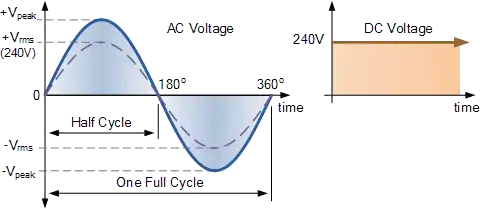So if an AC current means the elctrons are alternating or changing direction in a given time, how does this apply to live & neutral wire, don't they flow in one direction only? Please answer it as simple as possible, I'm only a high school kid.
4 Answers
This is a follow-up to a comment I left at the OP's closed question here
how does this apply to live & neutral wire, don't they flow in one direction only
Here's an image of 240VAC versus 240VDC
Stipulate that the live wire has 240VAC relative to the neutral (return) wire and that the neutral wire is held at 0V.
This means that the live wire is alternately more positive and then more negative with respect to the neutral wire.
Assuming a resistive load (imagine a light bulb connected between live and neutral), the mobile electrons in the bulb filament move away from the neutral towards the live wire when the live wire voltage is positive and move from the live wire towards the neutral when the live wire is negative.
Thus, the current through the bulb (and wires) alternates in direction as the live voltage alternates in polarity. That is, the current is an alternating current (AC) and not a DC (unidirectional) current.
- 60,633
As you have noted, there is a live and a neutral wire leaving the circuit breaker panel (*note 1) to your load. Because this is alternating current, during half of the cycle the circuit in the live wire is flowing out of the panel, and during the other half it flows in to the panel.
Now, the key here is that during the time that current flows out the live wire, it flows back in the neutral wire. The neutral wire completes the circuit, giving a return path for the current. Similarly, when the current flows in the live wire, it flows out the neutral. At any given time, whatever current flows through the live wire, an equal amount (*note 2) flows in the opposite direction through the neutral wire. It's a great example of Kirchoff's current rule!
(*note 1) Older panels use fuses instead of circuit breakers. In either case, at the panel the neutral is connected to Earth ground. But none of this matters for explaining your question.
(*note 2) When things are working correctly, the currents should be equal and opposite. Occasionally, the current finds another path back -- often through a human being, causing an electric shock. We call this a "ground fault". There are devices called "ground fault circuit interrupters" that measure the difference between the live and neutral currents; if the difference in current is large enough, they shut off the circuit. You can often see these devices in bathrooms and kitchens, with buttons labelled "TEST" and "RESET". Now you know what those are for!
- 772
- 1
- 9
- 17
My understanding is that the electrons are alternating between 2 hot wires which has a voltage of 240V. Imaging those two hot wires like left and right jabs from a boxer, and the neutral wire is neither the left or the right jab, but a third arm in the middle not jabbing at all....So the electrons come from left arm, then come from the right arm like alternating jabs, and all return through the middle arm. The voltage between the middle arm and the left or right arm is 120V. Since there is no electron coming from the middle arm (no jab), you won't get a electric shock, or punched:)
- 1
In a120 volt circuit the neutral wire carries current at 120 volts every other 1/2 cycle, however the voltage potential voltage potential between the neutral and ground is 0 because the neutral is connected to ground,ie there is no voltage potential difference.
